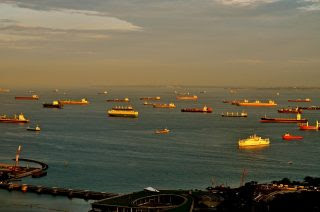Early indications of prices for low-sulphur fuel oil
0.5% compliant with the IMO 2020 rule showed that the new fuel costs about 30%
more than the current, high-sulphur IFO380 fuel at Asian ports which have
started selling it.
0.5% compliant with the IMO 2020 rule showed that the new fuel costs about 30%
more than the current, high-sulphur IFO380 fuel at Asian ports which have
started selling it.
According to shipping consultancy Drewry, the price is
based on actual bunkering transactions for ships which trade with Chinese
ports, where the 0.5% requirement is already implemented. The low-sulphur fuel
price in the major port of Singapore is about USD 560 per tonne.
based on actual bunkering transactions for ships which trade with Chinese
ports, where the 0.5% requirement is already implemented. The low-sulphur fuel
price in the major port of Singapore is about USD 560 per tonne.
However, industry players should be careful when using
these early price indications, because the demand for low-sulphur fuel will
increase considerably by November/December and market conditions will be very
different then.
these early price indications, because the demand for low-sulphur fuel will
increase considerably by November/December and market conditions will be very
different then.
Namely, Drewry predicted that bunker adjustment factors
(BAFs) will soar between the fourth quarter of 2019 and the first quarter of
2020, first, and “will be very volatile in the first half of 2020.”
(BAFs) will soar between the fourth quarter of 2019 and the first quarter of
2020, first, and “will be very volatile in the first half of 2020.”
Contractually, the ability of shippers and providers to
adjust their BAFs at an appropriate time towards the end of 2019 and at a fair
cost is a top priority for the next few months.
adjust their BAFs at an appropriate time towards the end of 2019 and at a fair
cost is a top priority for the next few months.
Shippers who have redefined their BAFs and their bunker
indexing mechanism to take into account the IMO 2020 change have nearly always
agreed that carriers need to be compensated for the price differential between
low-sulphur and high-sulphur fuel – even though some 5% of total capacity is
equipped with scrubbers.
indexing mechanism to take into account the IMO 2020 change have nearly always
agreed that carriers need to be compensated for the price differential between
low-sulphur and high-sulphur fuel – even though some 5% of total capacity is
equipped with scrubbers.
“We believe that the chances are that low-sulphur
bunker prices will, after increasing in 2020, fall in 2021 and 2022, as the
initial price premium decreases,” the shipping consultancy noted.
bunker prices will, after increasing in 2020, fall in 2021 and 2022, as the
initial price premium decreases,” the shipping consultancy noted.
But there will be several major indirect repercussions
from the switch to low-sulphur fuel regulations, such as that shippers will pay
a lot more attention and scrutiny to the BAFs than in the past, while smaller
ships – which tend not to be equipped with scrubbers or with efficient engines
– will be shunned by carriers even more than in the past.
from the switch to low-sulphur fuel regulations, such as that shippers will pay
a lot more attention and scrutiny to the BAFs than in the past, while smaller
ships – which tend not to be equipped with scrubbers or with efficient engines
– will be shunned by carriers even more than in the past.
Additionally, some aggregate ship capacity will be
scrapped and shipowners will incur capital losses on some of their now-obsolete
vessels, built at a time when pollution regulations were lenient.
Paradoxically, shipping lines with a high use of scrubbers will be able to
continue to buy a lot of high-sulphur fuel and will become more cost
competitive and better insulated from low-sulphur price volatility than other
shipping lines.
scrapped and shipowners will incur capital losses on some of their now-obsolete
vessels, built at a time when pollution regulations were lenient.
Paradoxically, shipping lines with a high use of scrubbers will be able to
continue to buy a lot of high-sulphur fuel and will become more cost
competitive and better insulated from low-sulphur price volatility than other
shipping lines.
“The one remaining area of uncertainty is whether
carriers will resort to more slow-steaming in the era of more expensive bunkers,”
Drewry concluded.
carriers will resort to more slow-steaming in the era of more expensive bunkers,”
Drewry concluded.
World Maritime News

